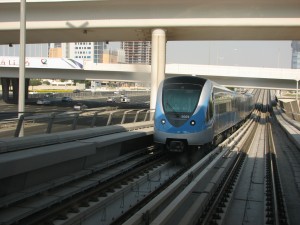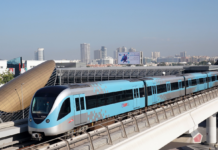By Robert Wright www.ft.com
A passenger heading to Dubai Marina from the metro station of the same name had better be in the mood for walking.

After an initial upward ride on an escalator, the route heads briefly parallel to the Sheikh Zayed road, which runs for the length of the elongated, sprawling city.
Then an air-conditioned bridge stretches 200 metres over Sheikh Zayed, some other roads and the construction site for the new Al Sufouh tram line.
Finally, a second set of escalators deposits the passenger at a stop for buses heading to the marina itself.
The scene illustrates the challenge the United Arab Emirates’ largest city faces in trying to introduce public transport in a place that, like many in the fast-developing Middle East, has grown up around wide roads and large distances that suit cars.
Planners knew from the start they would face a struggle persuading the city’s population to abandon comfortable motor vehicles when the physical barrier of the roads, the lack of pavements in many places and the sheer heat that lasts for much of the year were working in the car’s favour.
That the Gulf region’s first metro, opened in September 2009, is already sometimes uncomfortably full has encouraged a spurt of interest in the potential for other cities in the region to launch similar systems.
The question is what elements of the planning have made Dubai’s metro a success and what lessons it can teach other cities in the region that are considering similar schemes.
They include Abu Dhabi, the United Arab Emirates’ capital, and Doha, capital of Qatar.
Paul Abbosh, regional development manager for the Gulf at Atkins, the engineering consultancy, says such cities watched Dubai’s experience before deciding whether to build metros themselves.
“You’re now looking at a lot of activity in terms of metros across the Gulf,” Mr Abbosh says. “So they must have concluded it was a positive experience.”
Among the challenges the metro has had to overcome – and which may be still more severe elsewhere in the region – is the Arab world’s instinctive social conservatism.
Cars are popular not only because of their convenience but because they afford privacy for women and children.
Local Arabs – who make up some 20 per cent of Dubai’s population – can also be reluctant to mix with the Indians, Pakistanis and Filipinos who make up Dubai’s working class, according to Mohamed Mezghani, head of the Middle East office of UITP, the international public transport association.
“Public transport is seen as a mode used by those who have no choice,” he says.
Each train is equipped with a higher priced “gold class” section and another area solely for women and children.
Ramadan Abdulla Mohammed, head of rail operations in the rail section of Dubai’s Roads and Transport Authority (RTA), argues that locals’ take-up of the metro is reasonable, given that many live in villas in the more distant suburbs. Locals account for 7 per cent of journeys.
“Seven per cent is not a bad number,” Mr Mohammed says. “Locals are more car-oriented because their homes are far from the metro.”
Planning of the public transport networks has been surprisingly thorough for a city that often appears to be mushrooming uncontrolled out of the desert.
Mr Mezghani attributes that partly to the RTA’s position as an integrated transport authority overseeing multiple transport modes.
“In Europe, sometimes we try to fight for having separate authorities dealing with taxis and buses and cars,” he says. “We don’t have a lot of these integrated authorities.”
Vincent Prou, project director for France’s Alstom for the Al Sufouh tramway, says the RTA demanded careful “urban insertion reports” on how each of the 13 stations would link to its surroundings.
“It’s not simply a matter of a tram line drawn in the city,” he says. “It also requires careful thinking about what is happening around and how to integrate those stations with pedestrian access, bus stations and car parks.”
Even if station exits such as that at Dubai Marina are long, they are playing an important role in knitting Dubai together, according to Mr Abbosh.
Before the first metro line’s opening, there were only two pedestrian crossing points anywhere in the city over Sheikh Zayed Road.
There is cautious optimism that development will cluster close to metro stations, improving public transport’s attractiveness.
“You used to have to take a taxi to get from the Emirates Towers to the Rotana Hotel, which is pretty much exactly opposite on the other side of the road,” Mr Abbosh says. “The stations have bridged that gap.”
There remain journeys in Dubai that are time-consuming, expensive or inconvenient by public transport.
The metro’s introduction has boosted public transport’s share of passenger journeys in Dubai only from 6 per cent in 2006 to 8 per cent last year.
The many daily commuters from the neighbouring emirate of Sharjah remain particularly poorly served, because Dubai’s public transport all stops at or before the border.
But, in a city better known for leading the Middle East in brashness and conspicuous consumption, there remains, according to Mr Mezghani, an excellent chance that it may be helping to roll back the whole region’s dependence on the car.
“The potential is very high when you see a city such as Riyadh,” Mr Mezghani says.
















